Let’s play a game. Open a new browser window right now, go to Google, type in “new retail technology,” then click on the “News” tab.
What you’ll get is a snapshot of countless high-tech experiments retailers are conducting to entice shoppers into their stores or enhance operations and experience.
Now for the second part of the game. Wait seven days, and do exactly the same thing. Guaranteed, the results page you end up with next week will be filled with a completely different cross-section of innovations changing the way we interact with brands.
Compared with the last century, when retail remained relatively unchanged until the arrival of the internet, it’s easy to see the industry is currently in the midst of the biggest technological whirlwind it has ever experienced. And with every week that passes, things seem to get a little crazier.
Examples of initiatives being introduced at the moment are too numerous to list here. Besides, many of them are likely nothing more than fleeting fads or future failures. We’ve highlighted a selection we think are yet to make the massive impact they’re truly capable of in the world of physical retail.
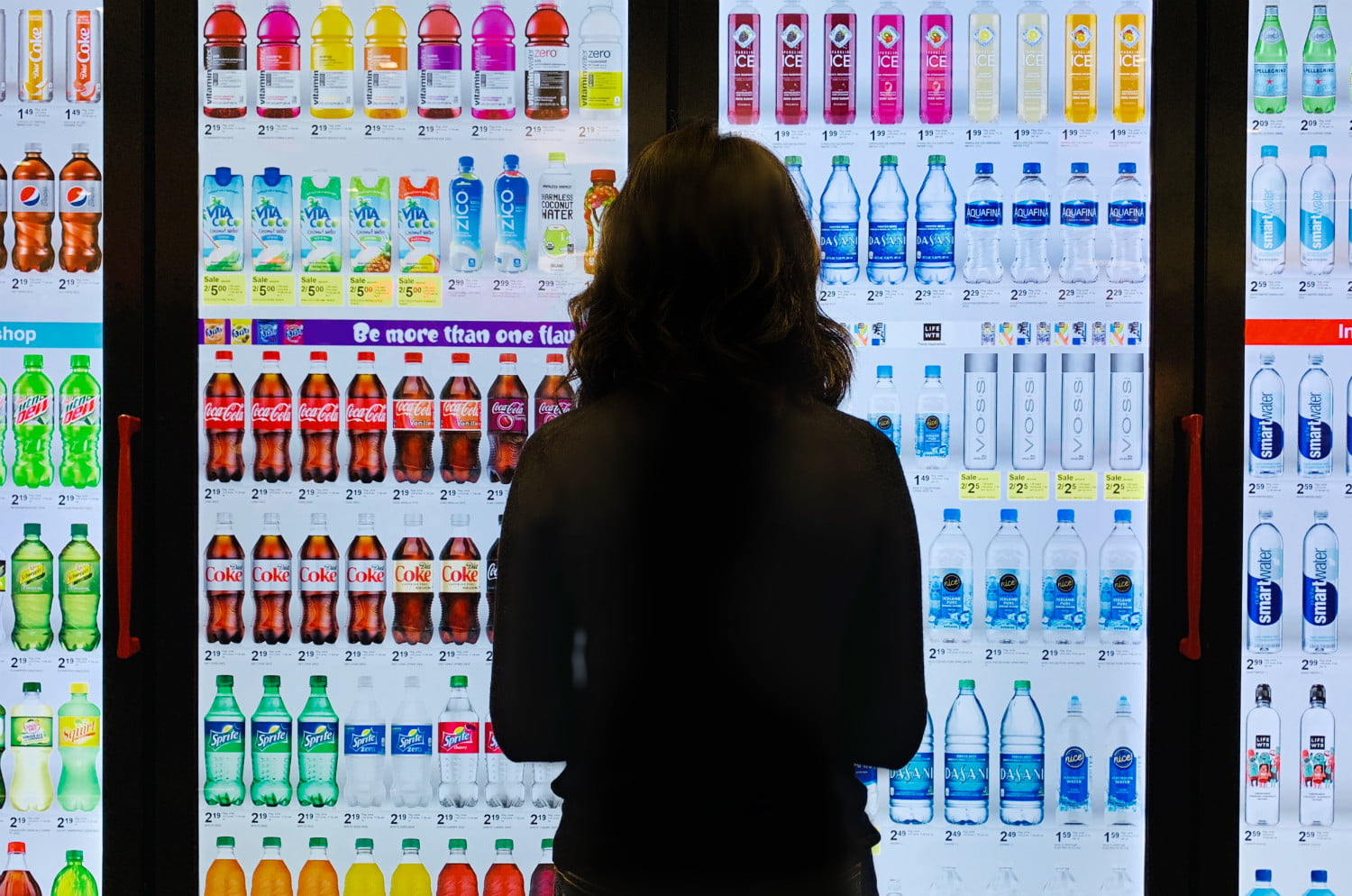 A Walgreens digital refrigerator door
A Walgreens digital refrigerator door
Data-Devouring Devices
The rate at which IoT devices are infiltrating the world around us is staggering. By 2025, it’s expected there’ll be 75 billion of them, close to a threefold increase from where we are today.
Retail is a big adopter. By the end of this year, it’s expected that 79 percent of retailers will have started using IoT gadgetry, up 30 percent in just two years. It’s not difficult to see why. Being able to track every single customer interaction in a store provides avalanches’ worth of actionable data.
Temperature and humidity sensors are examples that have been in use for some time now, but there are no limits on what to expect next. Last year, Walmart secured a patent for a shopping cart that can monitor a customer’s heart rate, potentially capable of sending biometric information to store attendants when shoppers are excited or distressed. Walgreens has deployed a camera-equipped digital refrigerator door that can track irises and guess the age of customers peering through.
The Living, Breathing Store
Combined with this barrage of information-gathering sensors, advances in cloud storage and artificial intelligence (AI) mean retailers will soon be able to examine customer movements much in the same way online marketers can gain insights from website analytics. This invaluable capability will inform everything from store design and merchandising to supply chain, inventory management, and consumer personalization (more on that later).
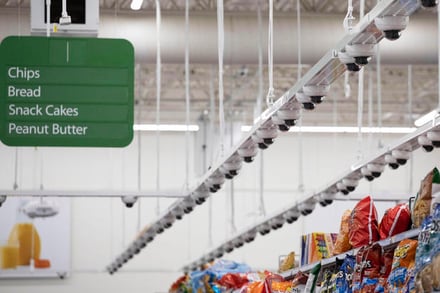 |
| Overhead cameras powering Walmart's IRL store |
Walmart’s recently opened “Intelligent Retail Lab” (IRL) in Levittown, New York is an early example. An actual store with real customers, its vast array of sensors, overhead cameras, and processors ensure the location’s shelves are never empty, as store attendants are alerted as soon as products need to be restocked. Oh, and did we mention the hardware is capable of collecting 1.6 terabytes of data every second? That’s roughly equivalent to 27,000 hours of music… captured every second. The retail giant will undoubtedly use this data to fuel further innovation. What’s more, IRL CEO, Mike Hanrahan, hints that should the technology prove a success, it’s very scalable.
Checkout-Free Shopping
It’s been nearly two years since the buzz around Amazon Go lit up the entire industry, but that doesn’t mean everyone’s forgotten about checkout-free technology. In fact, achieving a cost-effective frictionless shopping experience without compromising square footage or product range has become the holy grail of retail innovation. A sizeable crop of startups have since materialized, feverishly trying to find useable solutions brands can implement in-store.
UK grocery chain, Sainsbury’s, is currently undergoing a three-month trial of its own technology. Requiring customers to scan a QR code, it’s much simpler than Amazon’s iteration and costs much less to install.
But wait, here’s another example. Also here. And here’s a whole list of companies gunning to create the cashier-less store. We could go on, but basically, the Amazon Go concept has ignited the industry’s ingenuity to the point that a future without checkouts is likely closer than we all probably imagined.
Shelves That Advertise Directly to You
You’re a mother of two confused about what jar of mashed carrots to get for your one-year-old? Classic dilemma. In the near future, specific food brands might be able to guide your hand to their offering with targeted advertising displayed on dynamic shelves.
While this level of sophisticated personalization isn’t here quite yet, Kroger is an early leader, last year rolling out its “Enhanced Display for Grocery Environment” (EDGE) system — a digital display that can be updated to show pricing, promotions, and nutritional information. Later this year, its new partnership with Microsoft will also offer an enhanced version of the technology as a retail-as-a-service platform to other companies. Not only heavily influencing buying behavior, the technology will also provide grocers with an additional revenue stream, being able to offer highly-prized shelf real estate directly to CPG brands.
Retailin’ Robots
Before Skynet was created and the robotic uprising began, Terminator units were likely preceded by machines that help people shop — something that’s already a reality… in our reality.
Walmart is scaling up its rollout of autonomous, aisle-patrolling floor scrubbers and inventory checkers, introducing the bots at close to half of its stores by early next year.
In China, supermarket chain 7Fresh has started using robotic shopping carts that follow customers around the store. LG has developed a similar concept that’s capable of scanning items, displaying price and other product information on an integrated screen. It can also guide guests to items selected on a corresponding smartphone app.
Facial Recognition
Think we’re years and years away from a time when our faces are scanned everywhere we go? Think again. Shopping Center company NewMark Merrill is currently testing the tech at three of its locations, using facial recognition to track customers, foot traffic flow, as well as for loss prevention.
Meanwhile, on the other side of the world, at Alibaba’s Hema supermarkets, customers can literally pay with a flash of the face thanks to integration with the retail behemoth’s Alipay app.
Capabilities already exist for retailers to recognize when VIP customers enter a store. Facial features can also be used to log satisfaction levels straight into a company’s CRM or loyalty platform, though isn’t yet widespread.
Mobile Integration and NFC
While tech companies are already engineering the screenless society to come in a post-smartphone age, there are still many ways retailers can achieve greater integration between personal devices and physical stores.
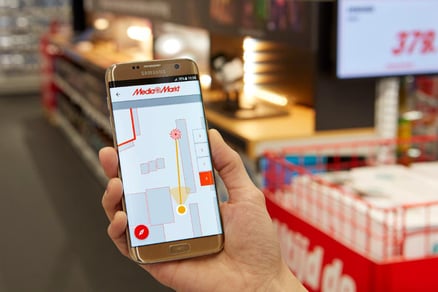 |
| Store Navigation at European chain Media Markt |
Retailers like Lowe’s were early pioneers of in-store navigation, allowing customers to have their phones guide them to the products they’re searching for. On top of that, roughly 30 percent of seniors and Gen Z customers expect improvements on this front within the next 10 years.
As beacon technology continues to get cheaper, more retailers are now creating personalized shopping journeys, hitting customers with promotion notifications specific to them via Bluetooth as they move about a store.
Near-Field Communication (NFC) may already be enabling the widespread use of payment platforms like Apple and Google Pay, however, the potential of the tech is far from realized. Brands are now able to communicate directly with customers in-store, embedding small, low-cost chips into products themselves, opening up a whole host of unexplored marketing opportunities.
VR and AR… But Mostly AR
In years gone by, VR and AR were basically written off as nothing more than gimmicky fads. However, as the technology improves, some retailers are managing to find useful applications.
Especially when it comes to AR. Today, as many as 75 percent of customers expect companies to provide augmented reality experiences and by next year, 100 million consumers will be using the tech. The widespread rollout of 5G will also provide a big boost to capabilities. Not only that, while VR requires additional hardware, the fact that smartphones can be used as an AR interface, makes it more of an accessible avenue for retailers.
In the past, brands like Rebecca Minkoff, Neiman Marcus, and GUESS have experimented with smart mirrors that can help customers accessorize and match items while trying products on in dressing rooms. Last year in the UK, Specsavers unveiled in-store tablets that match frame styles to customers’ faces, while Sephora has been using similar technology for some time.
However, rapid developments, such as Snap’s new AR utility platform, Scan, will provide endless opportunities for brands to create interactive experiences requiring nothing more than the devices already in customer’s pockets.
Product Personalization
Research shows customers like customization. 86 percent of Americans would like to have personalized electronics like cameras, phones, and tablets, for example. At the same time, they’re not getting what they want. Only 16 percent of these consumers believe brands are meeting their expectations on this front, making it a huge opportunity for retailers.
Adidas is aiming for in-store shoe printing within the next decade, while the potential of on-the-spot 3D printing in general remains relatively unexplored. Nike has experimented for some time with its in-store labs, allowing customers to use treadmills and other hardware to find the right fit. Its latest Manhattan flagship offers a peek at how personalized experiences can evolve.
Voice
By 2021, it’s estimated as many as 40 percent of consumers will shop with voice commands, spending close to a fifth of their budgets in the process.
Though when you start wondering how voice can be used in-store, it starts to get really interesting. The way voice AI is already being used at restaurant drive-thrus provides a preview of what could happen in physical retail. Automated bots can make menu suggestions based on what voices it picks up in a customer’s car. The backseat nattering of children, for example, could trigger a kids meal upsell. Voice interfaces may even help guests navigate a store.
According to Google’s Retail Innovation Lead, Chris Lydle, voice tech can also log a customers’ moods during in-store encounters — information companies could make use of later on, thanks to AI-powered analysis of recorded transcripts.
Honorable Mention: BOPIS
We know… we know. Buying an item online and picking it up store seems far from crazy… or even innovative. But if you think about it, having the ability to easily order a product on your mobile device as you’re leaving work to pick it up on your way home wasn’t possible five years ago. In fact, at many retail chains, this still isn’t possible, thanks to a lack of investment in the channel.
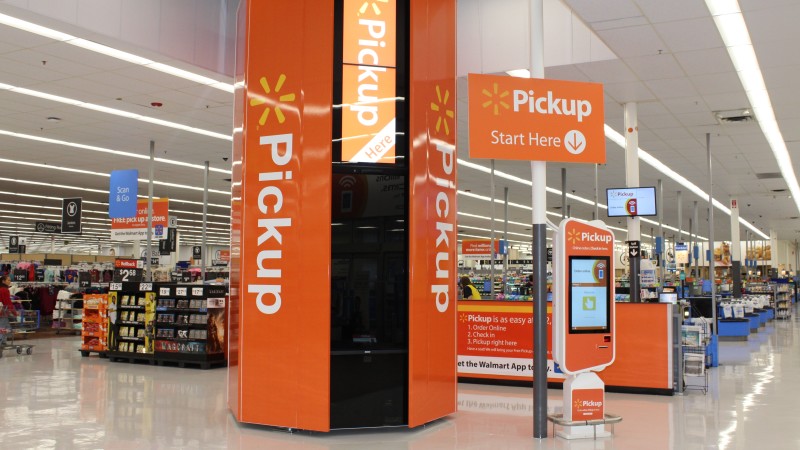
Walmart's in store pickup tower
However, amid ongoing store closures, buy-online-pickup-in-store (BOPIS) is a very real way for physical retail to remain a necessary part of consumers’ lives. Optimizing online channels, including search engine performance, in combination with simple brick-and-mortar enhancements is an easy win for retailers.
For retailers like Walmart that have gone the extra mile, installing massive pickup towers and accessible curbside collection, the payoff has been significant. BOPIS sales have boosted Walmart’s grocery performance, helping the company leapfrog Apple to become the nation’s third-biggest online retailer.
What Have You Seen on the Horizon?
So that’s our list. These technologies are just a handful of the innovations powering an unfathomable retail transformation to come.
It’s worth noting the distinction between online and offline retail has well and truly faded. In order for brick-and-mortar to thrive, store development and design leaders will have to embrace the latest advancements in a thoughtful and deliberate way if it’s to keep up with today’s consumer. Customers no longer think in terms of stores versus websites… they only care about what brands are willing to do for them. With this in mind, retailers need to approach the future with a one-channel mindset. Whatever can be done to provide the most seamless, convenient, and memorable shopping experience possible is the only thing that matters.
But we’d like to know what you think. Tell us what developing tech you think is going to have the biggest impact on physical retail in the comments below!
---------------------------------------------------------
We'd also love to continue the conversation around all things brick-and-mortar with you at RetailSpaces '19 taking place September 15-17 in Carlsbad, CA. Request an invite here.

Posted by
Physical Retail Reimagined.
RetailSpaces is a community for store development and design innovators.
March 29-31, 2026 | San Antonio, TX
Learn More!
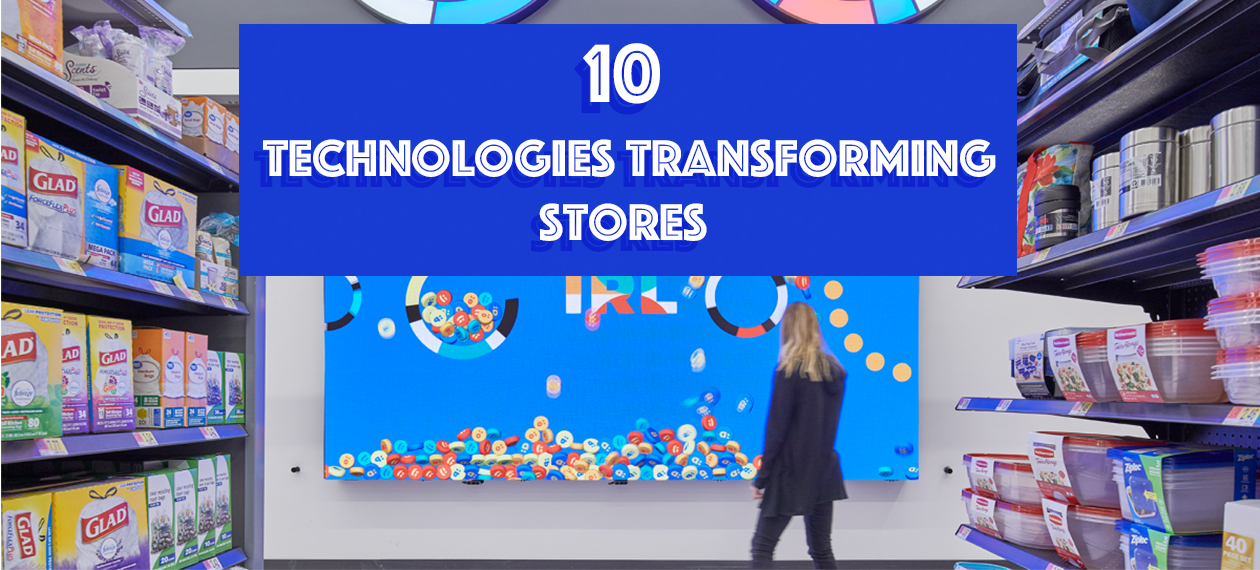







Comments